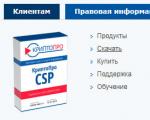How to increase the brightness of a photo in paint. Editing photos with standard Microsoft tools_let's make a photo lighter in a couple of clicks. An easy way to change the background
Posted on 02/14/2012 09:34 AM Paint Shop Pro X4 provides ways to adjust the brightness as well as the contrast in your images, which creates differences between light and dark pixels in an image. By applying commands to a selection or the entire image, you can do the following:
manually determine the brightness and contrast;
setting individual brightness in the image;
detection of highlights (75% tint), midtones (50% tint), and shadows (25% tint) to ensure smooth transitions between them;
distribute pixel brightness values more evenly from black to white;
increase in overall contrast when the histogram does not cover the entire spectrum of brightness;
determine the settings for brightness, contrast and gamma in the image;
creating a pure black and white image.
7.3.1. Adjusting Highlights, Midtones, and Darkness in an Image
The command Adjust → Brightness and Contrast→ Highlight/Midtone/Shadow(Adjust → Brightness & Contrast → Highlights/Midtones/Shadows). After executing this command, a dialog box opens. Highlight/Midtone/Shadow(Highlights/Midtones/Shadows) (Fig. 245).
If nothing is selected on the image, then the adjustment is carried out for the entire image.
 |
Rice. 245. Image tone adjustment |
Options Shadow(Shadow), mid tone(Intermediate tone) and highlight(Highlight) define values for shadows, midtones, and highlights in the selection, and if nothing is selected in the image, then for the entire image. The numerical values in these parameters depend on the selected position of the switch located below these parameters.
The switch at the bottom of the dialog box can take the following positions:
absolute adjustmentmethod(Absolute Adjustment Method) - Sets the positions to 25% for shadows, 50% for midtones, and 75% for highlights. Typical values are around 35 for shadows, 50 for midtones, and 65 for highlights, but these may vary depending on individual photographs. Increasing values brighten the area, while decreasing values darken it.
Relative adjustmentmethod(Relative adjustment method) - adjusts brightness levels relative to their initial states. Positive values brighten the area, while negative values darken it.
7.3.2. Installation histogram
The tone histogram allows you to analyze the tonal range of an image and redistribute the balance of shadows, midtones, and highlights.
To correct tones in an image or selection, execute the command Adjust → Brightness and Contrast→ Histogram adjustment(Adjust → Brightness and Contrast → Histogram Correction). After executing this command, a dialog box opens. Histogram adjustment(Histogram Adjustment) (Fig. 246).
 |
Rice. 246. Adjusting the histogram |
Switch Edit(Change) determines the type of histogram being edited:
Luminance(Lightness) - allows you to edit the histogram based on the brightness of the image;
color(Colors) - allows you to edit the histogram based on one of the image's color channels. After selecting this switch position, a list becomes available to the right of this position, in which you need to select a color channel based on which the active image will be edited.
Listed Presets(Parameters) offers ready-made adjustment options. When you select any of them, the radio button Edit(Change) is automatically reset to the position Luminance(Illumination). Preset value Default(Default) presents no additional settings in the image.
In the parameters located below the graph, you can change the values, both using absolute values and using relative (percentage) values.
Slider Low(Low) starts on the left side of the histogram, located between the left edge of the graph and the point where the curve begins to rise. This gap indicates that the dark pixels in the image are not completely black. This parameter displays the percentage of pixels that are between zero and a low value - their contrast will be lost. As a general rule, set the low value to less than 0.1%. This parameter can also be adjusted using the dark gray slider.
Slider high(High) starts at the right side of the histogram, located between the right edge of the graph and the point where the graph shrinks to zero pixels. This option changes the light pixels in the image to white. As general rules, set this parameter to less than 0.1%. This parameter can also be adjusted using the white slider.
Slider Gamma(Gamma) - If the overall image is too dark or too light, then you need to adjust the gamma, which is a standard measure of how contrast changes in images. If the image is too dark, then move the slider Gamma(gray triangle) to the right to increase gamma. If the image is too light, then move the slider Gamma to the left to decrease the gamma setting.
Slider Midtones(Midtones) (on the right side of the window) - if the graph has peaks on the left and right, or contains low values in the center, then the midtones need to be compressed. Shadows and highlights need to be expanded to show the information they contain. This often happens in flash photography when the subject is too close to the camera; The subject appears brightly lit, but the background of the photograph is created dark. To compress the midtones, move the vertical slider Midtones. If the chart peaks are in the center and have low pixel counts on the left and right sides, then expand the midtones by moving the slider Midtones down.
If you are creating artistic effects, you can use the controls outputmax(output max) () and output min(Output min) () to the left of the histogram. engine Max is a white circle on a gray background, and the engine Min is a black circle on a gray background. In order to darken the light pixels in the image, you need to move the slider Max down. In order to lighten the dark pixels in the image, you need to move the slider Min up.
Even if the sliders move along the vertical axis, the parameters Max And Min(range 0 to 255) affect the horizontal axis. All pixels outside the range are converted to be within the range.
If you just want to improve your image, then this option should not be used.
Triangular buttons below the slider Gamma(Gamma) determines the scale of the histogram and nothing else. The left button zooms in and the right button zooms out the histogram. Button 1:1 sets 100% histogram scale.
Color selection
The active color of the brush (base color) is changed by clicking the left mouse button, the active background color is changed by clicking the right mouse button.
Lines, curves, contours of figures are drawn with the color of the brush, and fill, spray, brush, pencil work in this color. The cavities of the figures are painted with the background color. The eraser, erasing the drawing, leaves behind the background color.
Color change
28 paints are placed on the color panel. If necessary, you can replace the color in the palette with another one: double-click on the color to be replaced or Palette - "Change Palette", then in the "Change Palette" window - select the desired color (out of 48 colors).
The computer allows you to work with millions of colors. Therefore, if you need a color that does not exist, you can create it yourself - the "Define Color" command

In addition to the "manual" selection, the color can be determined by its code - "Hue, Contrast, Brightness" or "Red, Green, Blue".
After setting the color, you can add it to the set of additional colors or change it in the palette (OK)
Task "Coloring"
1. Launch Paint. Set the sheet size to 585 x 640.
2. Insert a picture from the file "pictures \ hare.bmp" (Edit - Paste from File) 
3. Using the RGB color codes, color the picture according to the pattern. Try to paint over the contours of the areas as well. One way is to paint over the area first with black, then with the desired color. Another way is to set the desired color as the background color, black as the brush color, and using the colored eraser (ie holding the right mouse button), replace the color.
4. Save the drawing in your folder under the name "2-hare.bmp"
5. Create a new drawing (File - New)
6. Insert a picture from the file "pictures \ birdie.bmp"
7. Color it as you wish and save it in your folder under the name "2-bird.bmp"
Questions
1) What color will you get if you mix equal amounts of red, green and blue?
2) What color will you get if you mix equal amounts of red and blue?
3) How to get black and white color?
4) What color corresponds to the RGB(0,0,250) code?
The Adjustments menu in Paint.NET contains various commands for adjusting the color content of an image. There may be more commands in this menu depending on the number of external Paint.NET plugins connected. The image below shows a minimal view of the Adjustments menu as it appears in a freshly installed Paint.NET editor.
To illustrate the effect of each command from the "Correction" menu item, we will use the image below. This is the original image. In the description of most of the commands on this page, an example will be given - a drawing obtained from the original one by applying one or another Paint.NET command from the "Correction" menu.

Auto-align color levels in Paint.NET
Menu item "Auto leveling" in the "Correction" menu graphic editor Paint.NET is designed to color-align an image. Too dark or, conversely, too bright parts of the image will be displayed in the normal range. This command has no parameters. The result after applying level alignment to the original image can be seen in the figure below. This command is equivalent to the Levels adjustment with default settings and the Auto Level button pressed.

Adjusting Image Brightness and Contrast in Paint.NET
Menu item "Brightness and Contrast" is designed to make the colors in the picture darker or lighter, or to make them more contrasting. The dialog box of this function has two parameters: "brightness" and "contrast", respectively.
This is what the original image will look like if we make it brighter.

This is what the original image will look like if we make it more contrast.

And this is how the original image will look like if you make it brighter and more contrast at the same time.

Image size to fit window in Paint.NET
Team "Fit to window" scales the image so that it fits completely into the workspace. This is useful for large images to see the entire picture. At the same time, the execution of this command does not increase the scale of the picture by more than 100%, which can be seen using it on a small image.
Adjusting Color Curves in Paint.NET
The "Curves" command is intended for visual color management in the form of curves. This menu item "Curves" is devoted to a separate page of the manual.
How to make an image black and white in Paint.NET
Menu item "Make Black and White" provides an easy way to reverse the colors in an image and make it black and white with gray tones. An example of applying this correction over the original image can be seen in the figure below.

Changing the Hue and Saturation of a Picture in Paint.NET
Team "Hue and Saturation" used to change the saturation of colors in an image or change their hue. In addition, using this command, you can also change the brightness of colors. However, it is to change the brightness that you should use the special command "Brightness and Contrast", described above, because. the result of using this function may be different.
If you apply the Hue and Saturation command to the original image? with the value of the "hue" parameter 88 and the parameter "saturation" 158, the result will be as in the figure below.

How to make a photo negative in Paint.NET
Team "Invert Colors" its action is similar to turning a photograph into a negative. This command reverses the colors. So, if you apply this command to the image twice, you will get the original image again. If we apply this command to the original image from our example, the result will be as shown in the figure below.

Gamma and color range of an image in Paint.NET
The "Levels" command is used to change the color gamut and range of colors in an image. A separate page is dedicated to the "Levels" command.
Roughening Image Colors in Paint.NET
The Roughen command lets you reduce the number of available colors used in an image. Typically, for each color channel: red, green, and blue, there are 256 possible values (from 0 to 255). Using the Roughen command in Paint.NET, you can limit this value to between 2 and 64, per color channel. Reducing the number of colors gives the image the effect of an artificially aged or retro picture. Using the Roughen command for our example will give the following result.

How to make a sepia effect in Paint.NET
The Sepia command first converts the image to black and white and then adds a sepia tone. From history, one of the meanings of the term "sepia" is paint. Natural sepia was made from the ink sac of a cuttlefish. This paint was used by artists in the middle of the eighteenth century when drawing pictures. Natural sepia was used to tone photographs to brown. The effect of sepia in photography is the conversion of silver to sulfide, which becomes more resistant to fading. Therefore, many old black and white photographs are brown, so they have a better chance of not fading and surviving to this day. The application of the "Sepia" command to our example can be seen in the following figure.

Excel for Office 365 Word for Office 365 Outlook for Office 365 PowerPoint for Office 365 Excel 2019 Word 2019 Outlook 2019 PowerPoint 2019 Project Professional 2019 Excel 2016 Word 2016 Outlook 2016 PowerPoint 2016 Project Professional 2016 Excel 2013 Word 2013 Outlook 2013 PowerPoint 2013 Excel 2010 Word 2010 Outlook 2010 PowerPoint 2010 Excel 2007 Word 2007 Outlook 2007 PowerPoint 2007 Project Online Desktop Client Project Professional 2013 Project Standard 2013 Project Standard 2016 Project standard 2019 Less
Change screen brightness
Do you want to adjust the brightness screen ?
Windows 10: press the button Start, select an item Options, and then - system > screen. In chapter brightness and color set the slider change brightness to adjust the brightness. For more information, see Change screen brightness
Windows 8: Press the Windows key + C. Select an item Options, and then - change computer settings. Select computer And Devices, > display. Turn on automatic tuning screen brightness. For more information, see: Adjusting brightness and contrast
Read the article for information about picture adjustments in Office applications.
This video shows several ways to customize a picture.
(After you start playing the video, you can click the arrow size changes, at the bottom right corner of the video frame to enlarge the video.)

Duration: 1:35
Adjusting Brightness, Sharpness, and Contrast

Note: even if you have made the necessary corrections. This feature is not available in Word and Excel.
Change the Office color scheme to increase contrast
Is the Office color scheme too bright for you? Is it required more contrast in Office applications? See Change the Office theme (office 2016 and 2013) .
You can change the brightness, contrast, and sharpness of a picture using the correction tools.
Clockwise from top left: Original drawing, drawing with increased smoothness, increased contrast, and increased brightness.

Adjusting the Brightness and Contrast of a Picture

Advice: If you're using PowerPoint, you can still keep the original version of the picture even if you've changed the brightness of the picture. This feature is not available in Word and Excel.




